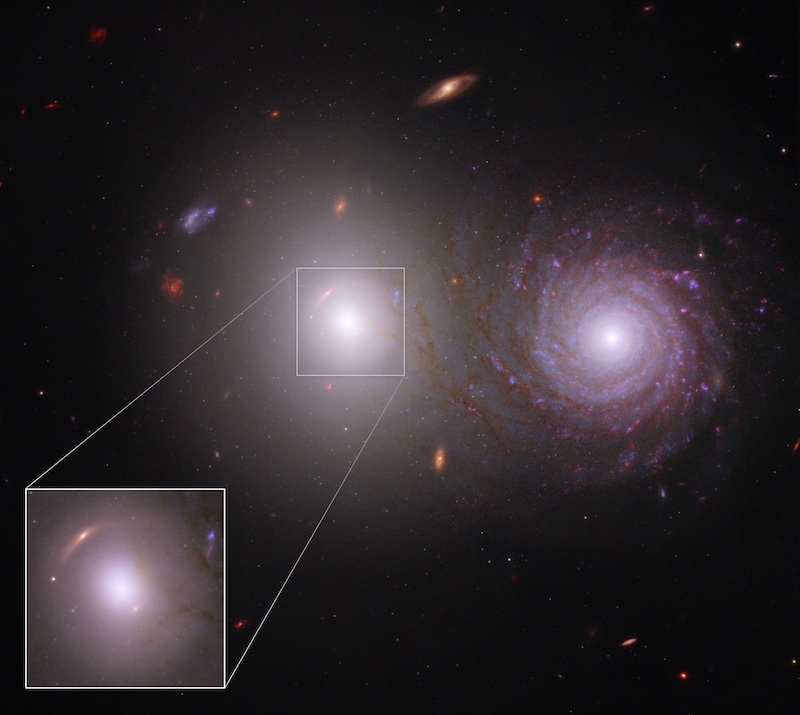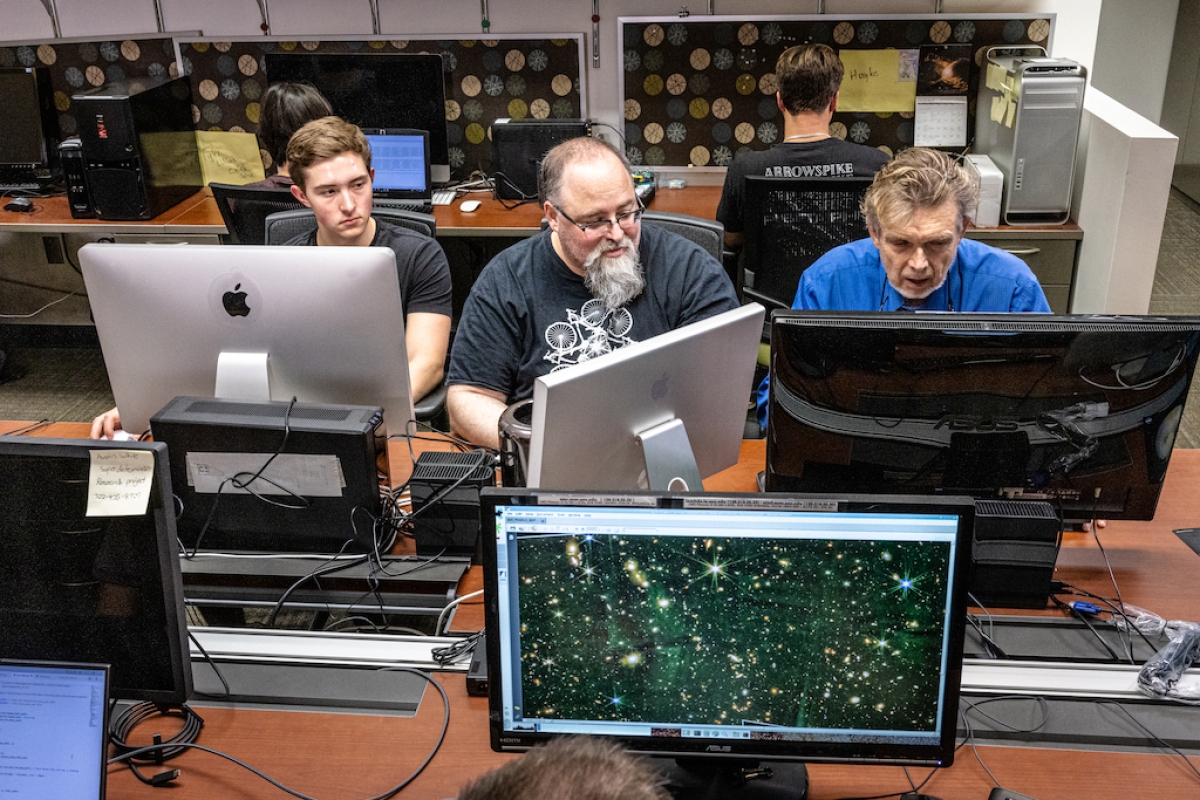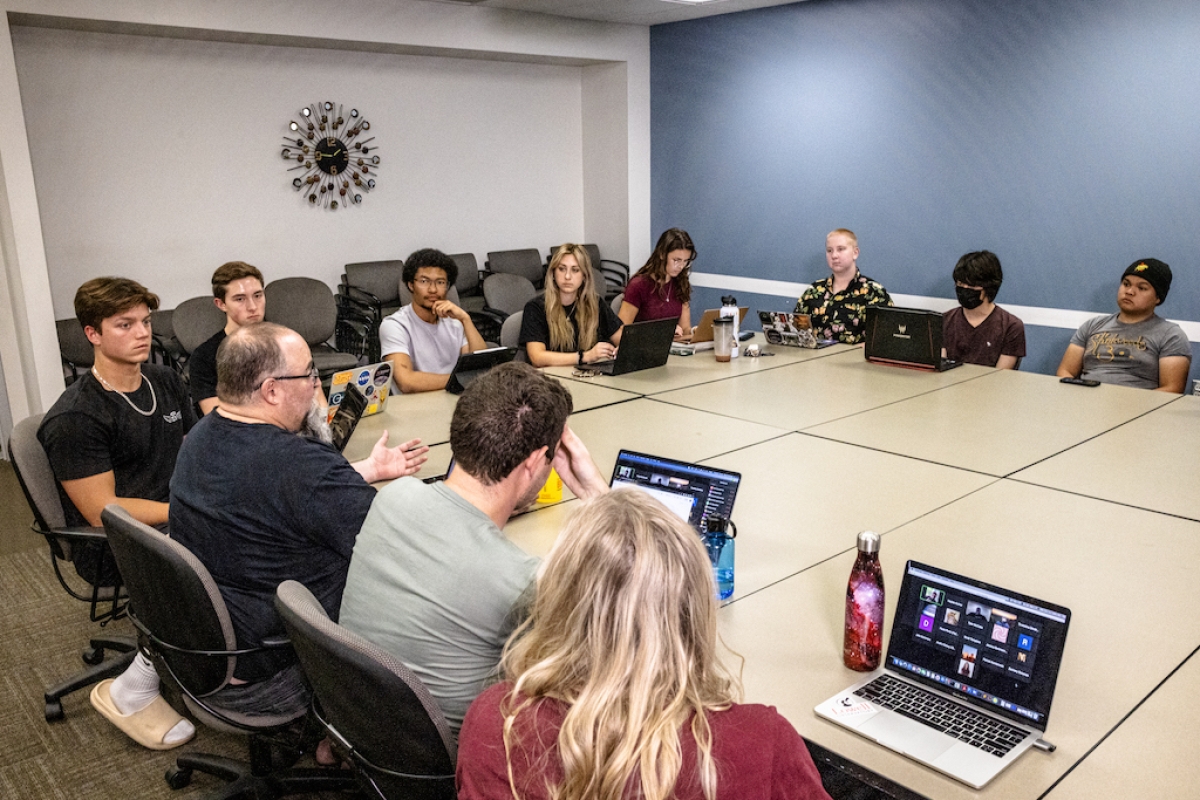Editor’s note: This story is featured in the 2022 year in review.
Arizona State University astronomers are sharing one of their first and most beautiful NASA James Webb Space Telescope images of a galaxy pair at a distance of about 700 million light-years away from us.
Using Webb’s new images and data, the scientists were able to trace the light that was emitted by the bright white elliptical galaxy through the winding spiral galaxy in front of it, allowing astronomers to identify the effects of interstellar dust in the spiral galaxy.
Webb interdisciplinary scientist and ASU Regents Professor Rogier Windhorst and his teamASU undergraduate student Jake Summers performed the pipeline data reduction. The dust analysis was led by William Keel of the University of Alabama, while the Hubble data acquisition was led by Benne Holwerda of the University of Louisville in Kentucky. The detailed gravitational-lensing analysis was conducted by Giovanni Ferrami and Stuart Wyithe, both of the University of Melbourne, Australia. obtained the data used in these images from early results of the telescope's Prime Extragalactic Areas for Reionization and Lensing Science (PEARLS) project.
“This is a rather unique opportunity to measure how much dust has been produced in this spiral galaxy, like our own, by previous generations of stars. Mind you that this is the kind of dust that the next generation of stars and planets, and in our case people, are also formed from,” Windhorst said.
Webb scientists are now able to delineate how star formation can happen in these kinds of galaxies from the gas and the dust that formed in the past. They folded in Hubble images to provide some of the bluish light, but almost all of this light is coming from Webb.
The Webb images used for this study observe wavelengths longer than those visible to the naked eye, but they are mapped onto our familiar family of colors to make our images. They are combined with Hubble data observing visible light to accurately model both the original light from the background elliptical galaxy, and how much it was reddened by the foreground spiral.
A sunset at the horizon, for example in Arizona, appears red because of dust in the atmosphere, and because our atmosphere transmits red light better than the blue light. The same principle applies in the Webb images.
The infrared light that Webb observes from the elliptical galaxy is very well visible in the images, even when passing through the dust of the foreground spiral. Windhorst says that most of this light is rendered as false color. You're not actually looking at blue or violet light, but at near-infrared light that has been rendered for the eye to see.

Above the white elliptical galaxy at left, a faint red arc appears in the inset at 10 o’clock. This is a very distant galaxy whose appearance is warped. Its light is bent by the gravity of the elliptical foreground galaxy. Plus, its appearance is duplicated. The stretched red arc is warped where it reappears — as a dot — at 4 o’clock. In this image, green, yellow and red were assigned to Webb’s near-infrared data taken in 0.9, 1.5 and 3.56 microns. Blue was assigned to two Hubble filters, ultraviolet data taken in 0.34 microns and visible light in 0.61 microns. Credit: NASA, ESA, CSA, Rogier Windhorst (ASU), William Keel (University of Alabama), Stuart Wyithe JWST PEARLS Team
Webb’s technology allows for a better visualization of the attenuation by dust that Hubble was not able to do. Webb’s eight new infrared filters allow for a more accurate analysis when mapping the attenuation by dust.
Windhorst explained that by comparing images of Hubble and Webb, the dust lanes in the foreground spiral become visible, the same dust that our solar system is made from when it formed our sun and its planets.
This dust now becomes visible because that background elliptical galaxy acts like a flashlight. It is the dust attenuation in this spiral galaxy that Windhorst and his team are trying to map, and it can be traced very well with the new Webb infrared images.
The Windhorst group combined data from Hubble and Webb to get some other surprising results. The image and data showed not only this a rather unique alignment of an elliptical in the background and a spiral galaxy they were trying to measure in the foreground, but they saw a strange-looking arc-shaped object behind the elliptical galaxy.
This is a distant galaxy seen within the first few billion years after the Big Bang. Its light was gravitationally distorted by the enormous mass of the elliptical galaxy, which is close to the mass of a hundred billion suns. And the very large mass of the elliptical galaxy stretches the very distant small galaxy into an arc.
The light from that distant galaxy is in reality almost directly behind the center of the elliptical, but its light comes around via two gravitationally bent paths: One is a stretched arc-like image, and the other is a faint counterimage on the other side of the elliptical galaxy center.
“We got more than we bargained for by combining data from NASA’s James Webb Space Telescope and NASA’s Hubble Space Telescope,” Windhorst said. “Webb’s new data allowed us to trace the light that was emitted by the bright white elliptical galaxy, at left, through the winding spiral galaxy at right — and identify the effects of interstellar dust in the spiral galaxy.”
Video by Steve Filmer/ASU Media Relations
The scientific paper was submitted recently to The Astrophysical Journal. The research has also allowed ASU-NASA Space Grant intern Jake Summers to be part of the working for the ASU Cosmology Research Group as part of the Webb Telescope PEARLS team.
“I find it astonishing how Webb can provide for completely unexpected findings, such as the lensed galaxy behind the elliptical galaxy in the VV191 system, with relative ease and with only half an hour of exposure time,” Summers said. “The resolution of Webb never ceases to amaze me — I was blown away by the fact that it can resolve individual globular clusters in the main elliptical galaxy.”
William Keel of the University of Alabama is the lead author of this study, with co-authors including Windhorst, and Seth Cohen and Rolf Jansen from the School of Earth and Space Exploration.
The VV191 galaxy pair was called to the attention of researchers by citizen science group Galaxy Zoo. Keel has been involved Galaxy Zoo for nearly 15 years and was initially drawn to the group for the ability of participants to pick out rare galaxy types, especially silhouetted or overlapping galaxy systems.
“VV191 is the latest addition to a small number of galaxies that helps researchers like us directly compare the properties of galactic dust,” Keel said. “This target was selected from nearly 2,000 superimposed galaxy pairs identified by Galaxy Zoo citizen science volunteers."
The James Webb Space Telescope is the world's premier space science observatory and was launched in December 2021. Webb will solve mysteries in our solar system, look beyond distant worlds around other stars and probe the mysterious structures and origins of our universe and our place in it. Webb is an international program led by NASA with its partners, the European Space Agency and the Canadian Space Agency.
Top image: Researchers traced light that was emitted by the bright white elliptical galaxy on the left through the spiral galaxy at right. As a result, they were able to identify the effects of interstellar dust in the spiral galaxy. Webb’s near-infrared data also shows us the galaxy’s longer, extremely dusty spiral arms in far more detail, giving them an appearance of overlapping with the central bulge of the bright white elliptical galaxy on the left, though the pair are not interacting. In this image, green, yellow and red were assigned to Webb’s near-infrared data taken in 0.9, 1.5 and 3.56 microns. Blue was assigned to two Hubble filters, ultraviolet data taken in 0.34 microns and visible light in 0.61 microns. Credit: NASA, ESA, CSA, Rogier Windhorst (ASU), William Keel (University of Alabama), Stuart Wyithe (University of Melbourne), JWST PEARLS Team
More Science and technology

ASU-led space telescope is ready to fly
The Star Planet Activity Research CubeSat, or SPARCS, a small space telescope that will monitor the flares and sunspot activity of low-mass stars, has now passed its pre-shipment review by NASA.…

ASU at the heart of the state's revitalized microelectronics industry
A stronger local economy, more reliable technology, and a future where our computers and devices do the impossible: that’s the transformation ASU is driving through its microelectronics research…

Breakthrough copper alloy achieves unprecedented high-temperature performance
A team of researchers from Arizona State University, the U.S. Army Research Laboratory, Lehigh University and Louisiana State University has developed a groundbreaking high-temperature copper alloy…




